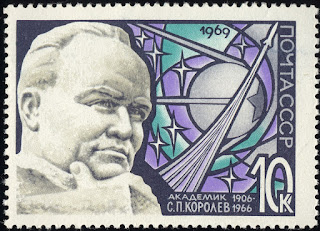Sputnik 1 was launched on 4th October 1957, thus giving the
Soviet Union the lead in the superpower space race. This achievement was
primarily due to the drive and genius of one man – Sergei Korolev, the
scientist who masterminded the top-secret space programme.
Born in 1906, Sergei Pavlovich Korolev was the chief
engineer at Russia’s Jet Propulsion Research Institute in the mid-1930s.
However, in 1938 he became a victim of Stalin’s purges and was tortured and
sent to the eastern Siberian gulag, where he worked in a gold mine and suffered
from scurvy. He also suffered a heart attack during his time there.
Released in 1944, he was appointed head of the secret Soviet
space programme. It was his idea to launch a satellite that was heavier than
anything the Americans could have considered launching at that time. It was a
relatively simple craft, comprising a metal sphere containing a radio
transmitter and batteries. For three weeks it orbited Planet
Earth sending out a simple beep that was designed to be heard by every
territory over which it passed and which chose to tune in, with the United States
being the chief intended target.
After the batteries ran out, Sputnik ran in silent mode
until 4 January 1958, when it re-entered Earth’s atmosphere and burned up. By
this time it had completed 1440 orbits and travelled some 43 million miles.
On 3 November 1957 Sputnik 2 was launched. This was a larger
satellite, particularly notable for carrying a dog into space. Named Laika, the
three year old female mongrel had been picked off the streets of Moscow to
become the first living creature to leave Earth’s atmosphere. There was never
any possibility that she would return to Earth, but she actually died sooner
than expected when a system aboard Sputnik failed and the capsule overheated.
Korolev continued to have many successes with Soviet space
missions, each one having the desired effect of catching the United States by
surprise. He designed the Vostock spacecraft that launched Yuri Gargarin into
space on 12th April 1961 and brought him back safely. In 1963 Valentina
Tereshkova became the first woman in space, and two years later the first
two-man crew was able to complete the first spacewalk.
The United States could only play catch-up with the Soviet
Union at this time, but all that changed after 1966, when Korolev died. He had
suffered poor health for many years as a result of his earlier ill-treatment in
the gulag, and he died on the operating table during colon surgery.
Korolev had always been a magnetic personality who was able
to control a highly complicated enterprise, but without him everything became
embroiled in politics and bureaucracy. The Soviet space programme thus came to
a virtual halt while the Americans went from strength to strength, culminating
in the Apollo moon missions that landed a man on the moon in 1969.
© John Welford

No comments:
Post a Comment